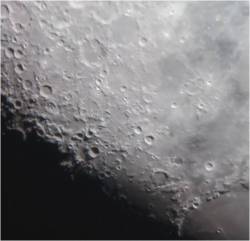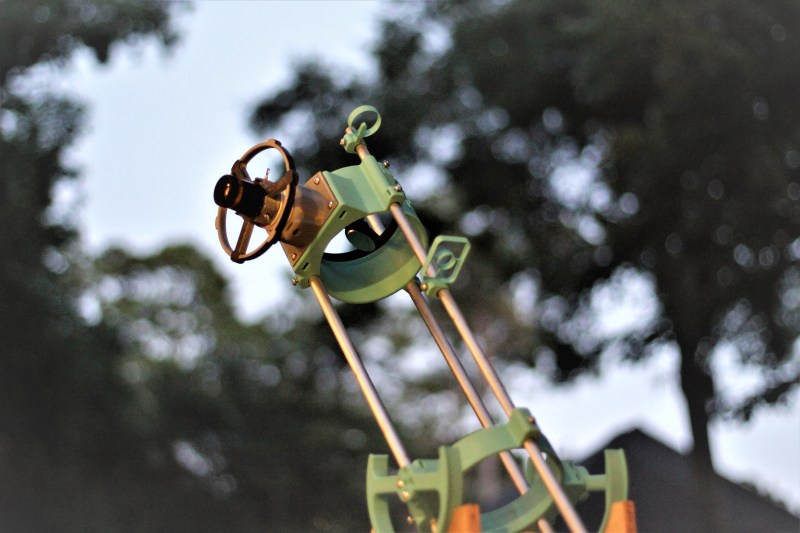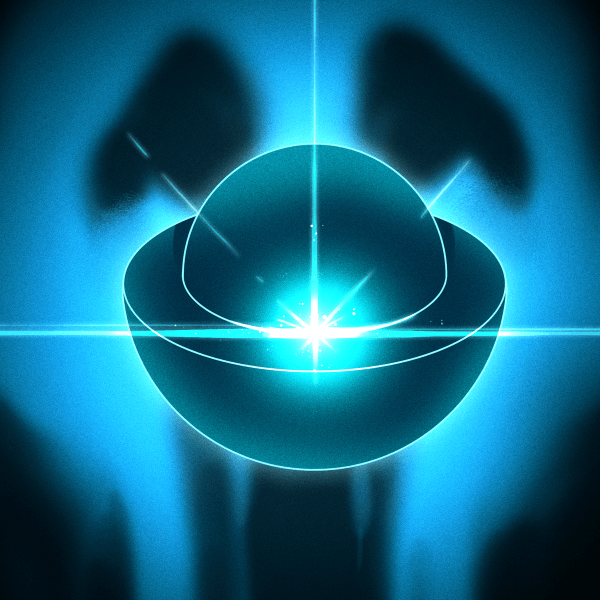Have you ever considered building your own telescope? Such a project can be daunting, especially if you grind your own mirrors. But with a 3D printer, hardware store bits and bobs, and some inexpensive pre-made mirrors, you too can be the proud owner of your very own own Hadley — a 114/900mm Newtonian Telescope that can cost less than $150 USD to build! Check out the video below the break to get a good scope on the project.

The creator’s stated goal is to “make an attractive alternative to the shoddy, hard to use “hobby-killer” scopes in the $100-200 range“, and we have to say that it appears to have met its goal admirably. The optics — the most complex part of any build — can be easily purchased online, and the rest of the parts are available at your local hardware store.
While the original build was provided in Imperial measures, a metric version is now available. Various contributors have created a rich ecosystem of accessories and alternative versions of various parts, all in the interest of making the telescope more useful. Things like tripod mounts, phone mounts (for use with your favorite star chart app) and more are only a click away. The only real question to answer is “What color filament will I use?”
Of course, sometimes light waves can get a bit long in the tooth, and for those cases you’ll want a radio telescope, which can also be DIY’d thanks to the availability of satellite dishes and SDR dongles!

















You mispelled “hardly”. It’s ridiculous what passes for editing on Hackaday these day’s!
Hardly… Hadley… SAMSONITE!
It was a pun using the design name. Perhaps you should wait to comment until you have a better command of the language the article was written in or at least learn to use an apostrophe.
wooooosh….
I think magic was being sarcastic.
They should have used a tone indicator like a civilized human being… /s
To what end?
Mic drop!
Perhaps the reference is to Hadley’s Rille, on the Moon. Hadley does not look like (especially capitalized) like hardly misspelled to me.
I thought it was a ref to Hadleys comet….
That’s “Headley”.
10 points for the Blazing Saddles reference!!!
Ha. Yes another 10 points for an on point blazing saddles reference.
Days… apostrophes do not pluralize a word.
Days not day’s!
Governor Lepetomane: Thank you, Hedy, thank you
Hedley Lamarr: It’s not *Hedy*, it’s *Hedley*. Hedley Lamarr.
Governor Lepetomane: What the hell are you worried about? This is 1874. You’ll be able to sue *her*.
What in the wide wide world a sports is a goin’ on here?!
Blazing saddles baby
It’s a scene from Blazing Saddles.
So was the “wide world of sports” quote.
I never watch sports so I wouldn’t know.
Howard Johnson is right
From Blazing Saddles in honor of the umpteenth “voters are actually in control of key policies” illusion reinforcement in the US next Tuesday:
“Gentlemen, we’ve got to protect our phony baloney jobs!”
The asparagus served in all the world’s finest restaurants is grown in Hadley Massachusetts. The locals are very proud and they call it “Hadley Grass”. Oddly, the asparagus sold in the Hadley Whole Foods is grown in Peru.
why not use pvc pipe instead of rods?. protects the mirror and have more rigidity against vibrations.
PVC definitely does not have more rigidity than the suggested steel or aluminium pipes
I talk about a big pvc pipe about 200 mm diameter to make a complete frame like most mirror telescopes
Oh, you actually don’t need to fully enclose the tube as long as you’re not, like, directly under a streetlight or something, and this is lighter and easier for the internals to assemble to. I’ve also found with mind it’s nice for explanations to be able to point to all the “working parts”. I have a printed cover I put over the primary mirror when I’m not out observing.
https://www.printables.com/model/238330-hadley-mirror-and-lens-covers
We’re in the process of making one of these. A PVC pipe might do a better job of preventing dust from falling on the mirror, but it would also add a lot of weight. It’s 3 ft long and more than 6 inches in diameter.
The metal has more rigidity in this simple truss (though PVC probably would be plenty rigid–the truss is pretty over-specced to resist wind loads and damp vibration). However, if you wanted to use PVC or something else, there’s a parametric version that allows matching the rod OD to whatever you have available. To my knowledge, Hadleys have been built with aluminum rods, steel rods, hollow-wall tube, metal conduit, and even oak dowels.
Please never clean a telescope mirror like that again! 😱
Haha I was cringing when I saw that :)
God, yes! I’m an old telescope guy. You had me cringing. You’re scrubbing those first surface mirrors like their your windshield. The general rule is do not touch the surface. Use a flow of distilled water & possibly some detergent. Do not clean it often! A little dust is harmess to the image quality. The evaporated aluminum coating is VERY fragile. Even if it has a protective coating like silicon monoxide on it. That coating too is very thin.
I talk about a big pvc pipe about 200 mm diameter to make a complete frame like most mirror telescopes
Sounds like you’re talking about a tube. Reflecting telescopes don’t need a tube, they simply need a framework or even a simple beam to hold mirror, secondary, and eyepiece in alignment. A century or so ago when amateur telescope making became popular, many a scope was nothing more than a 2×4 with a mirror holder at one end and the secondary+eyepiece at the other end.
“Amateur Telescope Making, Book 1″ by Albert Ingalls has a complete description of how to make such a telescope, including grinding and polishing the mirror. It’s quite dated, and the scope can’t handle high magnification, but it’ll show Saturn’s rings, Jupiter’s moons, and many other objects. Today you’ll probably get better results by buying a decent 6” (150 mm dia) mirror and secondary, and it’ll be less than if you made the mirror yourself.
For a telescope it’s about rigidity, not strength. PVC is extremely heavy and not nearly as rigid as a framework of aluminum tubing. Today amateurs who make very large scopes often use a cloth cover around the framework to shut out stray light. Much lighter than an enclosed tube.
And an enclosed tube has its own issues, e.g., convection currents running along the inside tube walls can foul up the image very, very well. :-(
I built a d=100mm f=1500mm with an achromat pair I got from Surplus Shed. Right now, it’s in a 4″ PVC tube, because that was easiest. Even with its shortcomings, it’s a lot of fun. I can see cloud bands on Jupiter and that absolutely stunned me. The moon almost feels like you’re flying over it. Cost was in the $250-500 range, and most of that was the objective set and the focuser. It’s mounted on a black pipe polar mount.
One of these days, I’m going to build another one with the 150mm objective set I got. Surplus Shed was selling off seconds from a lens company that went belly up and I grabbed them.
The zipper of your hoodie/jacket falling on your mirror while you’re crouched over the finder can foul up your mirror very very well also.
IMO there’s no call for open frame below about 10″ mirror, it just looks pretentious. Same kind of thinking as “big planes have double bogey tandem landing gear, so it must be best for my Piper Cub.”
I bought a secondhand 10″ mirror and cobbled something together out of two planks forming an L shape, and a shonky wooden mirror cell, and angle iron. The M6 threaded rod pivot bar for the mount passed straight across the mirror. It did work, and the main idea was to get some understanding how the optics would work, where best to place the focuser and secondary etc, for both eyepiece work and attaching a camera body. Next phase is to construct a spaceframe chassis for it out of aly, and then put it into a ball mount, these look pretty cool and I have a suitable plastic sphere already. Another project that has stalled! But, I have all the components. 2″ focusers are plentiful and cheap second hand.
It’s a 114mm telescope. Telescopes are sized by their primary mirror or objective lens diameter. A meter class scope is huge for an amateur.
900mm is probably referring to the focal length of the scope, which would roughly be an f/8.
I was wondering where they could get a usable 900mm mirror for under $150.
Edmund is still in business, but a slightly different name, and just selling opticals.
One of those glass patio tables with the center hole for the umbrella. A guy was heating one so it ‘slumped’ on to a concave form, grinding/polishing it, then took it to his friend who had a big vacuum chamber for aluminum deposition.
http://www.bbastrodesigns.com/slump/MoldMaking.html
Yeah and ummm, 114mm doesn’t exactly take it out of “hobby killer” range, spend more on bigger mirror, less on fancy, use a sonotube or something. Basic Dobsonian mount.
If you’re going to the effort, start at 6″, 150mm at absolute budget scraping minimum, 200mm or 8″ is a better size.
Mel Brooks is a gift we do not deserve. His autobiography is worth reading. Lots of inside stories about his productions.
Blazing Saddles is a film I never get tired of watching.
“De Camptown Ladies? No, Boss, I don’t think we know that one…”
This is just an excuse to use a 3d printer. It’s a toy. He doesn’t mention the altitude bearings, but hopefully they’re teflon pads. The lazy susan is going to be so loose that touching the scope will throw it off target. It takes a screwdriver to change an eyepiece. The finder is a joke.
You can usually find a 114mm scope on Craig’s list for about $100. Throw away the crappy equatorial mount and make a simple Dobson mount out of plywood and you will have something usable.
I’m about to make one. It sounds like you have made one too, since you are very knowledgeable about its shortcomings. If you have made some improvements to yours I’d love to hear about them.
By the way, this is one of the reasons I like Hackaday. Sometimes I see articles about the same topics published elsewhere. No biggie. But quite often I see something I hadn’t encountered before which really interests me, like this one, so I’m happy that Hackaday brought it to my attention.